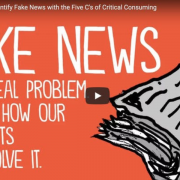Protocols to Help Students with Research in PBL
An Expansive View of Research
When we think of research, it’s easy to jump straight into online research. We often imagine it as something that older students do. However, toddlers are researchers because the process of asking questions and finding answers is one of the earliest skills we develop as humans. If you’ve ever spent an afternoon with a four-year-old, you’ll notice just how often they ask the question, “Why?”
When it comes to PBL, we can incorporate student research in a myriad of ways. Here are just a few of the types of research students might do:
- Reading articles online
- Checking out books
- Reading data sets and looking for trends
- Conducting surveys or needs assessments
- Interviewing experts
- Listening to podcasts
- Viewing videos
- Looking at diagrams or pictures
- Conducting short experiments
- Playing
- Observing a natural phenomenon
- Observing people
This is by no means an exhaustive list. But the idea is that we can design our PBL units to incorporate a broad variety of research into our student projects. However, sometimes students struggle with the research process, both in terms of asking questions and finding answers. Let’s explore some strategies to help with generating research questions and engaging in online research.
Teaching Students to Analyze Research Questions
Research questions will vary from project to project. If students are interviewing an expert, they’ll likely choose questions that are open-ended and they’ll focus on potential follow-up questions or clarifying questions as well. If they examine data, they might have some very math specific questions about trends as well as the validity and reliability of the source. However, if they engage in online research, they will generate questions that are specific, on-topic, and fact-based.
As a teacher, you can scaffold this process for them by using the following collaborative protocol:
- Students generate questions independently. They might need sample questions or sentence stems, but they can all create questions.
- Once they have their questions, they can send them to a Google Document or submit them on a Google Form. Or if you want to go old school, students can have chart paper and smelly markers. Seriously, Mr. Sketch markers are the best. I don’t care about being Google Certified or Apple Certified but if Mr. Sketch ever does a certification, I might just do it.
- Students analyze the questions to see if they are actually research questions. Each member has a role:
- Member #1: Is this question fact-based?
- Member #2: Is this question on-topic?
- Member #3: Is this question specific?
- Member #4: Quality control
- Members #1-3 can put a star by each question that fits their criteria. So, member #1 looks at each question and puts a star by questions that are fact-based. Meanwhile, member #4 is available to help and observe. Then member #4 double-checks all the questions with three stars and circles or highlights it if it’s an actual research question.
Note that a struggling student might still be able to do the job of member #1 or 2 while a more advanced student can do #3. Meanwhile, the group member who typically dominates and achieves at a top level learns to trust other members and wait and observe. However, they can still provide expertise as the quality control person who has the final say.
 Download the Interdependent Protocol for Generating Research Questions
Download the Interdependent Protocol for Generating Research Questions
The Five C’s of Critical Consuming
Once students have generated their research questions, they can begin engaging in online research. Often, they’ll return to their bank of questions but they might also find new questions they want to pursue. This research process is a chance to develop important information literacy skills — which has become more important than ever.
According to a Stanford study, only 25% of high school students were able to identify an accurate news story when also given a fake one. Students also had a hard time distinguishing between real and fake photographs as well as authentic and staged videos.
Researchers used the words “bleak” and “dismaying” to describe it. But it’s not going away anytime soon and that’s a very real problem.
So, how do we fix it?
Well, here’s a five-step process that I’ve used with students. A word of caution. It’s not perfect and there are probably other models out there but I thought I would share it just in case you might want to use it. We call it the 5 C’s of Critical Consuming. Here’s how it works:
#1: Context – Look at the context of the article. When was it written? Where does it come from? Have the events changed since then? Is there any new information that could change your perspective?
#2: Credibility – Check the credibility of the source. Does the site have a reputation for journalistic integrity? Does the author cite credible sources? Or is it satirical? Is it on a list of fake news sites? Is it actually an advertisement posing as a real news story?
#3: Construction. Analyze the construction of the article. What is the bias? Are there any loaded words? Any propaganda techniques? Any omissions that you should look out for? Can you distinguish between the facts and opinions? Or is it simply all speculation?
#4: Corroboration: Corroborate the information with other credible news sources. Make sure it’s not the only source making the claim. If it is, there’s a good chance it’s actually not true.
#5: Compare: Compare it to other news sources to get different perspectives. Find other credible sources from other areas of the ideological or political spectrum to provide nuance and get a bigger picture of what’s actually happening.
Below, you’ll see the 5 C’s of Critical Consuming, which includes the student handout and the video I shared on YouTube.




Leave a Reply
Want to join the discussion?Feel free to contribute!